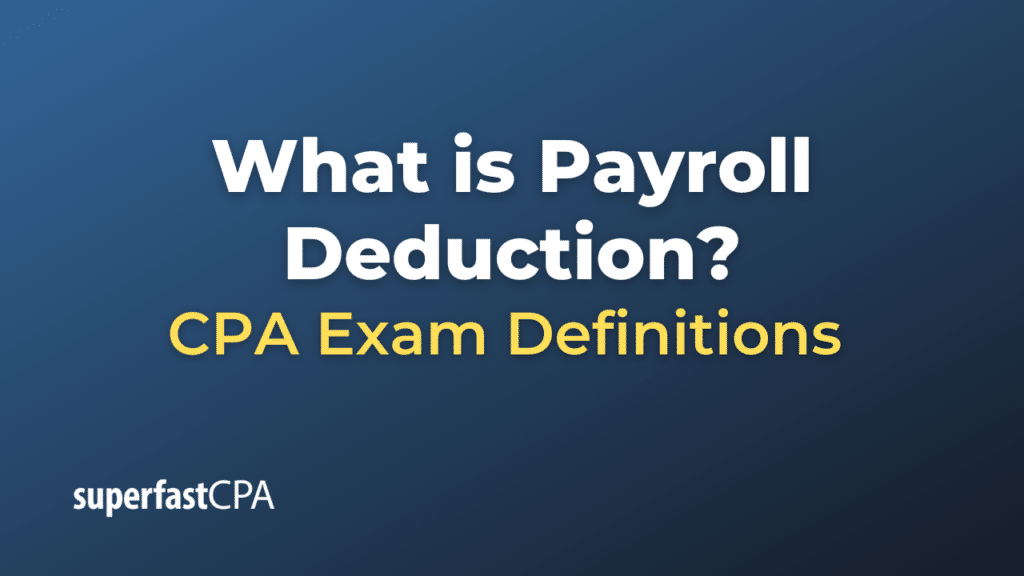Payroll Deduction
Payroll deductions are amounts of money that are taken out of an employee’s gross pay before they receive their net pay or take-home pay. These deductions can be mandatory, as required by law, or voluntary, based on options the employee chooses.
- Mandatory Deductions: These are required by various laws and must be withheld from an employee’s wages. Examples of mandatory deductions include:
- Income Taxes: Employers are generally required to withhold federal, state, and sometimes local income taxes from their employees’ wages.
- FICA Taxes: In the U.S., employers are required to withhold Social Security and Medicare taxes, collectively known as FICA (Federal Insurance Contributions Act) taxes.
- Wage Garnishments: If an employee has a legal judgment against them for unpaid debts, child support, or alimony, the employer may be required to withhold a portion of the employee’s wages to satisfy the debt.
- Voluntary Deductions: These are deductions that employees choose to have taken out of their wages. Examples of voluntary deductions include:
- Health Insurance Premiums: If the employer offers health insurance, employees may have their portion of the premium deducted from their pay.
- Retirement Contributions: If the employer offers a retirement plan, such as a 401(k), employees may choose to have a portion of their pay deducted and contributed to the plan.
- Life or Disability Insurance : Employees may choose to purchase additional insurance coverage.
- Flexible Spending Accounts or Health Savings Accounts: Employees may choose to contribute to these accounts for healthcare or dependent care expenses.
All of these deductions are typically itemized on an employee’s pay stub so that the employee can see their gross pay, total deductions, and final net pay. Employers are also responsible for remitting these deductions to the appropriate entities, such as the IRS for tax withholdings, insurance companies for premiums, or creditors for garnishments.
Example of Payroll Deduction
Let’s consider a hypothetical example of an employee named Alex who works at a company, “Smart Solutions.”
Alex earns $60,000 per year, or $5,000 per month before taxes and other deductions.
Here’s how a typical monthly payroll deduction might break down:
- Mandatory Deductions:
- Federal Income Taxes: Alex falls into the 22% tax bracket for federal income tax. But due to the progressive nature of tax, Alex’s effective rate is not a full 22%. After accounting for various deductions and credits, let’s say $800 per month is withheld for federal income taxes.
- State income taxes: Alex lives in a state with a flat 5% income tax rate. Therefore, $250 ($5,000 * 0.05) is deducted for state income taxes.
- FICA Taxes: Alex’s Social Security tax is 6.2% of gross wages up to the annual limit, and the Medicare tax is 1.45% of all wages. Combined, these FICA taxes come out to 7.65% of gross wages, or $382.50 ($5,000 * 0.0765).
- Voluntary Deductions:
- Health Insurance Premiums: Alex is enrolled in the company’s health insurance plan, which costs him $200 per month.
- 401(k) Contributions: Alex contributes 5% of his gross wages to his 401(k) retirement account. That’s $250 ($5,000 * 0.05) per month.
In total, Alex’s monthly deductions would be:
Federal income tax: $800
State income tax: $250
FICA taxes: $382.50
Health insurance: $200
401(k) contribution: $250
Total deductions: $1,882.50
So, if Alex’s gross pay is $5,000, after all deductions, his net (take-home) pay would be $3,117.50 ($5,000 – $1,882.50).
This example provides an illustration of payroll deductions. The exact amount deducted can vary greatly depending on an individual’s earnings, tax situation, benefits, and state of residence.













